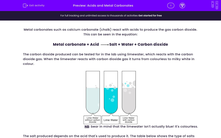Metal carbonates such as calcium carbonate (chalk) react with acids to produce the gas, carbon dioxide. This can be seen in the equation:
Metal carbonate + Acid ![]() Salt + Water + Carbon dioxide
Salt + Water + Carbon dioxide
The carbon dioxide produced can be tested for in the lab using limewater, which reacts with the carbon dioxide gas. When the limewater reacts with carbon dioxide gas it turns from colourless to milky white in colour.
.png)
NB: bear in mind that the limewater isn't actually blue! It's colourless.
The salt produced depends on the acid that's used to produce it. The table below shows the type of salts that are produced from these acids:
| Acid Name | Type of Salt | Formulae |
| Hydrochloric Acid | Chloride | HCl |
| Sulfuric Acid | Sulfate | H2SO4 |
| Nitric Acid | Nitrate | HNO3 |
The name of the salts produced is better illustrated in an equation:
Hydrochloric Acid
Magnesium carbonate + Hydrochloric acid ![]() Magnesium chloride + Water + Carbon dioxide
Magnesium chloride + Water + Carbon dioxide
MgCO3+ 2HCl![]() MgCl2 + H2O + CO2
MgCl2 + H2O + CO2
Sulfuric Acid
Calcium carbonate + Sulfuric acid ![]() Calcium sulfate + Water + Carbon dioxide
Calcium sulfate + Water + Carbon dioxide
CaCO3+ H2SO4![]() CaSO4 + H2O + CO2
CaSO4 + H2O + CO2
Nitric Acid
Sodium carbonate + Nitric acid ![]() Sodium nitrate + Water + Carbon dioxide
Sodium nitrate + Water + Carbon dioxide
Na2CO3+ 2HNO3![]() 2NaNO3 + H2O + CO2
2NaNO3 + H2O + CO2
Hopefully, that makes it a bit clearer!

Shall we try some questions now? Remember that you can look back at this page by clicking the red help button on the screen at any point.








